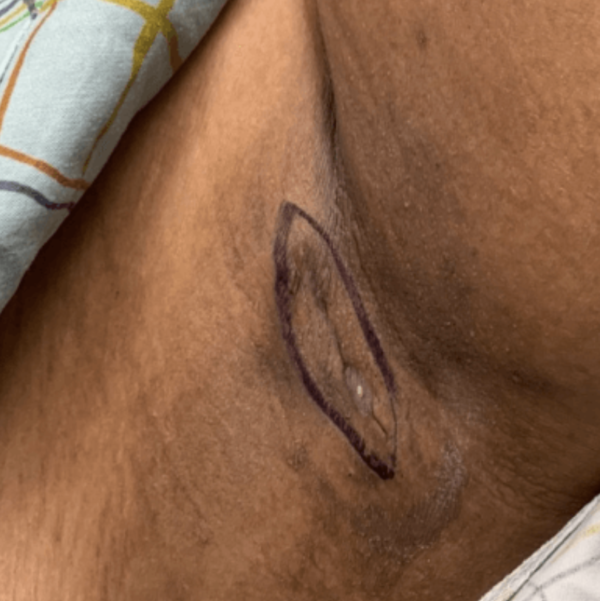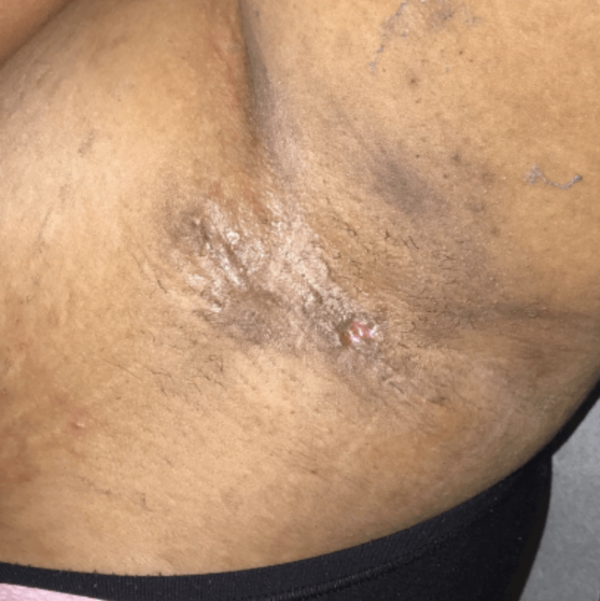Hidradenitis Overview
A serious skin condition that can greatly affect a patient’s daily life is hidradenitis suppurativa. This long-term disease is rare and can be very painful for sufferers.
The condition is characterized by small and painful lumps that are underneath the skin. In turn, the lumps can split open and emit an odor. The lumps can also cause tunnels to form beneath the skin. The lumps form on parts of the body where the skin comes into contact with itself, such as the armpits, under the breasts, the groin, and the buttocks. To alleviate painful symptoms and help a patient maintain his or her quality of life, Ashburn, VA Double board certified General and Plastic surgeon, Dr. Timothy Mountcastle, offers several surgical procedures. The main treatments include medical therapy such as humira for extenesive disease or for isolated disease surgery is the best option.
Hidradenitis Before and After
See More ResultsSurgical Technique
Doctors will often use any number of medications to treat hidradenitis. These can include antibiotics, anti-inflammatory drugs, hormones, immunosuppressants, and pain medications like morphine and codeine. When drugs alone don’t work, surgical procedures might need to be performed. The only medication that effectively clear disease are drugs such as Humira. Surgery mainly includes incision and drainage for active infections with abscess or an elliptical surgery excision with primary wound closure.
With incision and drainage, a small incision will be made in the sore and the contents will be drained out. This is mainly used for active draining infections.
Surgical removal involves removing all of the damaged skin with multiple different closure techniques. A skin graft is sometimes needed to close the wound after surgery but is not recommended as the first line of treatment.
Having performed this type of surgery since 1999 has provided an ample amount of evidence that the best type of treatment is surgical excision having the lowest recurrence rates, and best outcomes after surgery.
During/After Surgery
With incision and drainage local anesthesia is usually only needed. With tissue-sparing excision with electrosurgery and surgical removal, general anesthesia would be needed. The length of time of any procedure is dependent upon the patient’s condition and severity. More invasive procedures will require a longer recovery period. Since surgical removal may require skin grafting, additional procedures may be needed. It’s also important to note that even with surgical intervention, the symptoms of hidradenitis can return and will require additional treatment. This is one of the key points. Surgical removal requires not just macroscopic but also microscopic removal of all the affected apocrine sweat glands which are the root cause of the problem.
Hidradenitis Faqs
Are there home treatments for hidradenitis?
There are certain things that you can do at home, such as following a skincare regimen where you use gentle cleansers and your hands to wash your body and not washcloths or loofahs. Avoiding tight clothes can also help the skin and avoiding injuring the skin is another solution.
What are the risk factors?
Women are more affected than men and it’s more common in women in their 20s. There can also be a genetic component to hidradenitis since it seems to run in families. Having other chronic conditions like arthritis, diabetes, and Chron’s disease can increase the likelihood of developing the condition. Smoking has also been associated with hidradenitis.
Will insurance cover the cost?
Since hidradenitis is a chronic, painful condition, insurance should cover the costs of treatments. Depending on your insurance, a portion or all related costs might be covered. It’s important to reach out to your insurance company to ensure coverage.
Financing Available
Financing InfoRequest An Appointment
Contact Us
